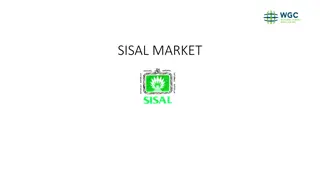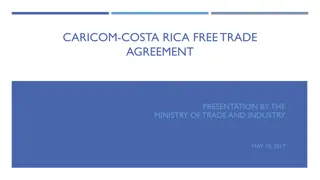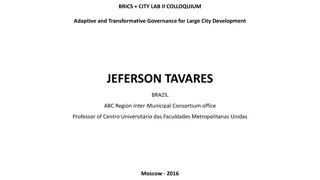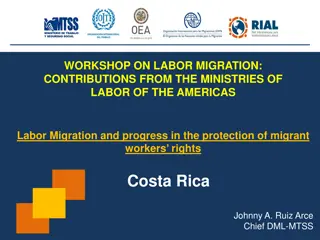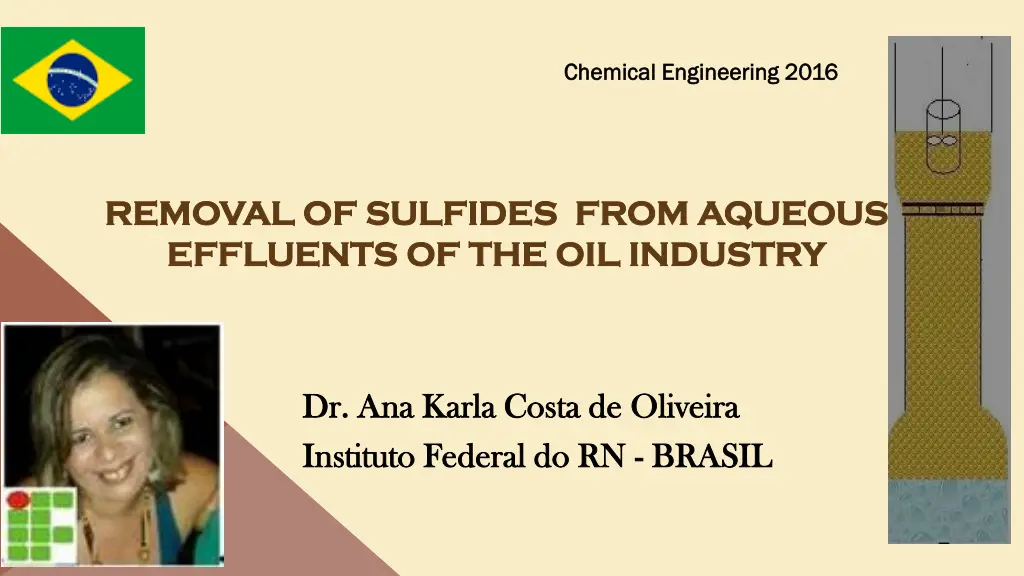
Efficient Removal of Sulfides from Oil Industry Effluents using Advanced Processes
Explore innovative methods for removing sulfides from oil industry effluents, including oxidation with hydrogen peroxide and caustic extraction. Learn about the role of amines in effluent treatment and the effectiveness of various tested amines in the process. Discover the conditions and solutions for efficient effluent treatment in the oil and gas sector.
Uploaded on | 0 Views
Download Presentation

Please find below an Image/Link to download the presentation.
The content on the website is provided AS IS for your information and personal use only. It may not be sold, licensed, or shared on other websites without obtaining consent from the author. If you encounter any issues during the download, it is possible that the publisher has removed the file from their server.
You are allowed to download the files provided on this website for personal or commercial use, subject to the condition that they are used lawfully. All files are the property of their respective owners.
The content on the website is provided AS IS for your information and personal use only. It may not be sold, licensed, or shared on other websites without obtaining consent from the author.
E N D
Presentation Transcript
Chemical Chemical Engineering Engineering 2016 2016 REMOVAL REMOVAL OF EFFLUENTS OF THE OIL INDUSTRY EFFLUENTS OF THE OIL INDUSTRY OF SULFIDES SULFIDES FROM AQUEOUS FROM AQUEOUS Dr. Ana Karla Costa de Oliveira Dr. Ana Karla Costa de Oliveira Instituto Federal do RN Instituto Federal do RN - - BRASIL BRASIL
PRODUCED PRODUCED WATERS WATERS Produced waters are complex mixtures which contain a large number of contaminants including finely dispersed oil, metals, and gases such as H2S and CO2, that are originated from oil and natural gas.
WATER SAMPLE CONAMA RESOLUTION 357/2005---to reuse water, with respect to class 3, the values allowed for H2S and oil content are 0.3ppm and 20 ppm, respectively.
OTHER PROCESSES PROCESS PROCESS DESCRIPTION DESCRIPTION OXIDATION WITH HYDROGEN PEROXIDE The hydrogen sulfide removal process, in the form of sulfur or sulfuric acid via anodic oxidation of sulfuric acid. CAUSTIC EXTRACTION Thet are able to extract sulfur compounds in the form of mercaptans.
PROCESS DESCRIPTION The process consists of putting the hydrocarbon solution into contact with the contaminant, and the adsorbent impregnated with metals that show affinity with sulfides. ADSORPTION PHYSICOCHEMICAL SOLVENTS Processes with physicochemical solvents use a mixture of physical and chemical solvent. The physical solvent is responsible for removing the largest amount of acid gases, while the chemical solvent puts on the finishing touches.
AMINES Amines with carbon chains longer than 6 are practically insoluble in water by hydrophobicity. The basic nature of amines increases their reaction power with sulfuric acid.
AMINES AMINES TESTED AMINES TESTED MOLECULAR FORMULA MOLECULAR FORMULA DUOMEEN DUOMEEN O O OLEYL-RNHCH2CH2CH2NH2 ARCUAD ARCUAD 2 2C C- -75 75 R2N+((CH2)2Cl) DUOMEEN DUOMEEN T T TALLOW-RNHCH2CH2CH2NH2
CONDITIONS Amines DUOMEEN O ARCUARD 2C-75 DUOMEEN T Amount of amine/ % Jet Fuel (v:v) 0.01; 0.05; 0.10; 0.25;0.50 O/A Ratio (Organic/Aqueous) (v:v) 1/3
PROCESS PROCESS The batch system is shown in Figure 1. It consists of a magnetic shaker (Tecnal-Brazil) (1) used to homogenize the extractant with the solvent (jet fuel), which was kept in a beaker (2). The organic material is sent through a micropump (Cole-Parmer, Brazil) (3) to a separation funnel (4), where the organic and aqueous phases, contaminated with sulfides and fine oil, are mixed. At the base of the separation funnel, the treated water was analyzed in a DR 2000
RESULTS AMINES REMOVAL OF SULFIDES(%) 76% 59% 42% DUOMEEN O ARQUAD 2C-75 DUOMEEN T
RESULTS The figure The figure below O O produced produced the below presents presents the the best best result. the results results of of sulfide result. sulfide removal removal with with the the use use of of three three amines amines, , showing showing that that DUOMEEN DUOMEEN
RESULTS RESULTS
CONCLUSION It was concluded that the Duomeen O amine, solubilized in jet fuel caused a higher percentage of H2S removal (76%) and resulted in a low TOG value of 5mg/L in the treated water, at a fraction of 0.25% amine/jet fuel. Despite the similarity between the amines Duomeen o and Duomeent, the latter did not obtain satisfactory results, due to the large unsaturation in the structural composition of Duomeen T, making it more soluble in water, which was not the aim of this study, and resulting in low sulfide and oil removal efficiency. The turbidity results confirm good oil removal with Duomeen O.
REFERENCES BAYATI, F.; Shayegan J.; NoorjahanA. Treatament of Oil Field Produced Water byDissolvedAir Precipitation/Solvent Sublation,Journal of Petroleum Science and Engineering v.80, p.26-31, 2011. BURNS K. A.; Codi S.; Furnas M.T.; Heggies, D. Holdway, D.; King B. A. and MCallister F. A. Dispersiom and Fate of Produced Formation Water Constituents in an AustralianNothwest Shelf Shallow Water Ecosystem. Marine Pollution Bulletin v.38:p.593- 603, 1999. HADJEV D., Aurelle Y. Phase inversion: a method for separation of fine liquid-liquid dispersions. The Chemical Engineering Journal v.58, p.45-51,1995. KOHL, A., Nielsen, R. Gas Purification. 5th Edition, Gulf Publishing Company, Houston, 1997. MORAES, N. A.; Paulo, J. B. A; Medeiros, G. S. Influence of Main Processes Variables onthe treatment of waste Waters using a new technology (MSPI). Brasilian Journal of Petroleum and Gas. V.5, N.2. p.75-85, 2011. RUFFORD, T.E., SMART S., Watson, G.C.Y. , Graham, B.F. , Boxall, J. , Diniz da Costa , J.C., May, E.F. The removal of CO2 and N2 from natural gas: Areview of conventional andemerging process technologies Journal of Petroleum Science and Engineering p.94-95, p.123 154,2012. ZHANG, Y.; GAO B.; Lu, L.; Yue, Q. Wang Q.; Jia, Y. Tratment of Produced water from polymer flooding in oil production by the combined methody of hydrolysis acidification-dynamic membrane bioreactor coagulation process. JournalofPetroleum Science andEngineering, v. 74 p.14 19, 2010.



![Halal_Chicken_from_Brazil-_Ensuring_Quality_and_Authenticity[1]](/thumb/86918/halal-chicken-from-brazil-ensuring-quality-and-authenticity-1.jpg)

